- Home
- »
- Reports
- »
-
Electric Vehicles Procurement Intelligence Report, 2030
![Electric Vehicles Procurement Intelligence Report, 2030]()
Electric Vehicles (EVs) Procurement Intelligence Report, 2023 - 2030 (Revenue Forecast, Supplier Ranking & Matrix, Emerging Technologies, Pricing Models, Cost Structure, Engagement & Operating Model, Competitive Landscape)
- Published Date: Sep, 2023
- Base Year for Estimate: 2022
- Report ID: GVR-P-10545
- Format: Electronic (PDF)
- Historical Data: 2020 - 2021
- Number of Pages: 60
Electric Vehicles Category Overview
“Rising fuel prices and increased environmental concern are driving the growth of the category.”
The global electric vehicles (EVs) category is expected to witness a CAGR of 14.5% from 2023 to 2030. Electric Vehicles are considered a sustainable and viable medium for transportation and are witnessing significant adoption as an alternative fuel vehicle due to rising technological advancement, increasing environmental awareness, rising prices of fuel across the globe, and supportive government regulations.
With the rise in concern over the intensification of climate change and air pollution, business enterprises and consumers are increasingly adopting EVs with an objective to lower their carbon emissions, contributing towards a sustainable and greener future.
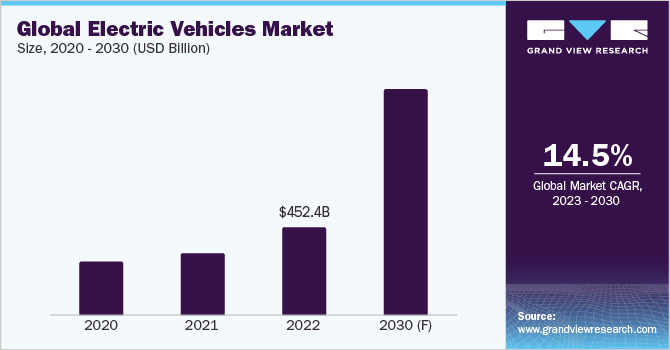
The primary reason for the category’s increased annualized growth is the strong demand for alternative fuel vehicles. These vehicles are gaining popularity as a result of the negative environmental impact of internal combustion engine (ICE) automobiles and the increase in their fuel prices.
The industry is also witnessing growth as consumers of today are getting more inclined to use hybrid or battery-powered vehicles. Every model has at least one electric motor for propulsion. For EVs, electricity serves as the primary energy source. They are not equipped with an internal combustion mechanism.
Vehicles powered by fossil fuels are one of the major contributors to air pollution, globally. As a result, to reduce vehicle emissions, numerous regulatory bodies have been obliged to impose rigorous emission standards on automakers.
It is expected that gasoline will run out in the future because it is a fossil fuel and is not a renewable source of energy. Therefore, alternative fuel sources must be developed and utilized to promote sustainable growth. Hence, electric vehicles are being promoted as they are more cost-effective than conventional vehicles and do not require gasoline. In contrast to gas-powered vehicles, which convert roughly 16.5% - 20.5% of the energy stored in gasoline, EVs can convert over 49.5% of the electrical energy from the grid to power the wheels. In addition, EVs also have a significant advantage in maintenance costs.
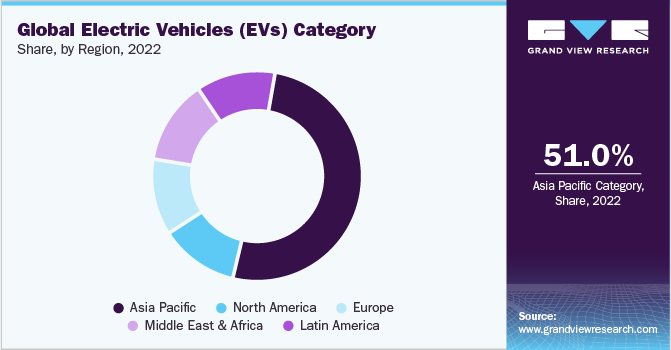
The demand for EVs is also being fueled by stringent government regulations across the world. For instance, the European Union has set a goal of achieving net-zero emissions by 2050. Since the emissions from electric vehicles are comparatively much less than those from conventional vehicles, governments across the globe are raising awareness and encouraging the use of EVs to cut down air pollution, fuel consumption, and related emissions. For instance, the governments of Norway and the Netherlands are doing promotional campaigns to enhance the adoption. As a result, the category will grow throughout the forecast period at a noteworthy rate.
In the first quarters of 2023, EVs accounted for one out of every seven vehicles sold globally. 73% of the quarter's EV sales were battery electric vehicles (BEVs), with the remaining sales being plug-in hybrid electric vehicles (PHEVs). The US surpassed Germany to overtake as the world's second-largest EV market, with China continuing to hold the top spot. Despite a 12% drop in overall passenger vehicle sales in China, EV sales registered a surprising 29% YoY gain. During the quarter, EV sales in the US increased by over 79% YoY. In Q1 2023, the top 10 automotive groups, which include 48 automobile brands, controlled the global EV category, accounting for three-fourths of all EV sales worldwide.
Supplier Intelligence
“What best describes the nature of the electric vehicles category? Who are some of the main participants?”
The global electric vehicles category features a moderately fragmented landscape with the top players majorly being based out of Asia, Europe, and North America. The category is witnessing increased competition. Several new players, mostly from China but also from other emerging nations are entering the market and offering more affordable options of EVs. A new wave of significant EV announcements, including fully electric fleets, increased investment, and vertical integration with battery manufacturing and essential minerals, were made in 2022-2023 by major incumbent carmakers, particularly in Europe.
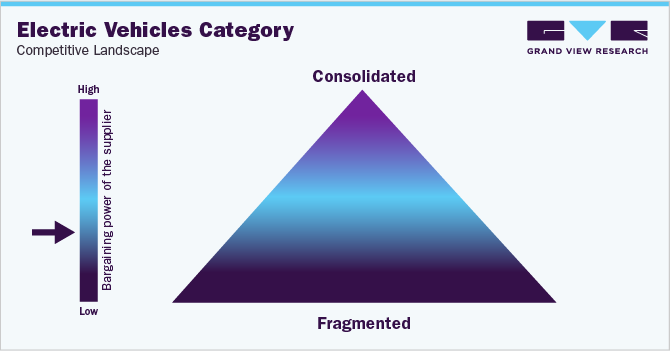
A growing variety of electric automobile options are available to consumers. By 2022, there were over 499 electric car models in the Chinese market, more than twice as many as there were in the previous year. Original equipment producers (OEMs) must provide reasonably priced solutions outside of China, to facilitate the widespread use of EVs.
Key suppliers covered in the category:
-
BMW AG
-
Tesla, Inc.
-
Volkswagen AG
-
General Motors Company
-
BYD Company Limited
-
Mercedes-Benz Group AG
-
Nissan Motor Co., Ltd.
-
Toyota Motor Corporation
-
SAIC Motor Corporation Limited
-
Stellantis N.V.
-
Ford Motor Company
-
Hyundai Motor Company
-
Renault SAS
-
XPeng Inc.
Pricing and Cost Intelligence
“What is the total cost of ownership for an electric vehicle? What variables affect the prices?
The total cost of ownership for an electric vehicle can be divided into major categories such as - vehicle cost, financing, insurance, purchase taxes, annual registration fee, maintenance, and other additional expenses. Other expenses can be further bifurcated into home charger cost, electricity purchase, liquid fuel purchase, electricity taxes, and liquid fuel taxes.
In January 2023, American Automaker, Tesla lowered the prices of its electric vehicles, putting more pressure on its competitors. As a result, many automakers in the industry are facing losses, particularly the emerging ones that have yet to turn a profit.
Depending on the model and the market, Tesla's price drop of about 19.8% expands its total addressable market. This is further aided by the fact that more of its models, particularly in the US, will be eligible for subsidies in 2023 than they were in 2022. Price reductions are also beneficial in markets where subsidies have been eliminated.
Tesla can act quickly and adjust to local market conditions because it isn't constrained by a dealer network, marketing initiatives, or managerial structure. In contrast to many competitors, it benefits from economies of scale and the ability to produce rapidly because of its enhanced manufacturing capacity and efficiency. The price reductions may affect Tesla’s margin and annoy customers who paid more, but the company will benefit from more cars on the road since it will have more options to monetize its software and services.
Following the price cut by Tesla, in February 2023, major automakers such as Toyota, Honda, Nissan, Mercedes-Benz, BMW, Volkswagen, Xpeng, NIO, and BYD also slashed the prices of their EV offerings, which eventually sparked a pricing war in China. At first, it was anticipated that the price war would quickly come to an end, resulting in more profitable sales for auto OEMs. However, some Chinese automakers have reported lower earnings, and in some cases losses, as the price war continues.
The cost structure is broken down in the accompanying chart. Other costs can depend on multiple cost components, which have been illustrated below:
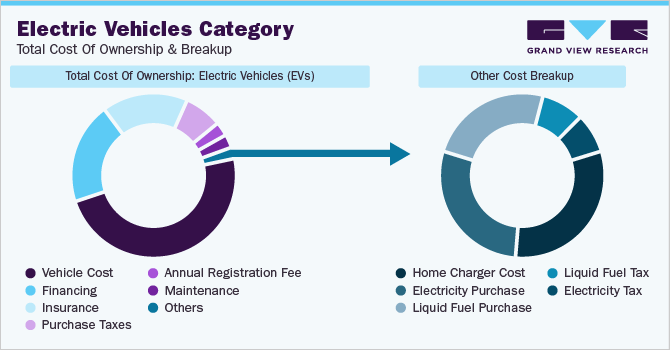
The report provides a detailed analysis of the cost structure and the pricing models adopted by prominent suppliers in this category.
Sourcing Intelligence
“How do electric vehicle manufacturers engage with their suppliers? What is the type of engagement model?”
Electric vehicle manufacturers typically follow a hybrid outsourcing model to engage with their suppliers. An electric vehicle does not involve as many components that are required to manufacture an internal combustion engine (ICE) vehicle such as exhaust systems, starter, alternator, fuel injector, etc., rather the major components involved in the assembly of an EV include battery pack, controller, electric motor, power inverter, DC-to-DC converter, etc.
With regards to the electric vehicles sourcing intelligence, the majority of the large players in the industry manufacture components like electric motors, power electronics, battery packs, and software systems in-house but they largely outsource the manufacturing of batteries, transmissions, and battery management systems as these are more complex to develop in-house and would require heavy investments.
Except few, the majority of the EV manufacturers in the industry were traditionally manufacturing ICE vehicles. They didn’t have a manufacturing division that used to develop batteries, and the batteries required in an EV are far more delicate than the regular automotive batteries. Hence, batteries for EVs are typically outsourced.
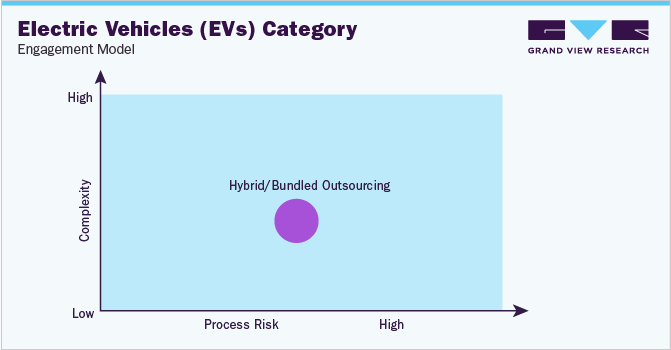
“In a hybrid/bundled outsourcing model, some part of the overall operation is outsourced to third parties. Generally, critical operations are retained in-house.”
Companies choose approved provider operating models to generate more cost savings, lower security-related risks, and ensure better delivery flexibility. Since for certain components such as electricals, tires, steering systems, transmission, etc., the suppliers would be the same who already support the ICE division of a respective manufacturer. Therefore, the players prefer to continue business with them to ensure quality, lead time, and efficiency.
Asia Pacific currently dominates the EV industry, especially in China, in terms of EV sales and manufacturing. In March 2024, sales of EVs increased in China by 10.5% as compared to March 2023. China remained the global leader in EV sales with a 28% YoY growth. Passenger EV (BEV + PHEV) sales increased globally by 18% in the first quarter of 2024. Likewise, other nations in the region such as India, Japan, and South Korea are working to boost the adoption of EVs in the coming times. In addition, Japan and South Korea aim to be one of the top 5 manufacturers of electric vehicles across the globe by 2030.
The report also provides details regarding day one, quick wins, portfolio analysis, key negotiation strategies of key suppliers, and low-cost/best-cost sourcing analysis.
Electric Vehicles Category Procurement Intelligence Report Scope
Report Attribute
Details
Electric Vehicles Category Growth Rate
CAGR of 14.5% from 2023 to 2030
Base Year for Estimation
2022
Pricing Growth Outlook
5% - 10% (Annually)
Pricing Models
Cost plus pricing model, fixed price pricing model
Supplier Selection Scope
Cost and pricing, past engagements, productivity, geographical presence
Supplier Selection Criteria
Type of EV, driving range, power & torque, charging specifications, energy consumption, type of battery and capacity, and other factors
Report Coverage
Revenue forecast, supplier ranking, supplier matrix, emerging technology, pricing models, cost structure, competitive landscape, growth factors, trends, engagement, and operating model
Key Companies Profiled
BMW AG, Tesla, Inc., Volkswagen AG, General Motors Company, BYD Company Limited, Mercedes-Benz Group AG, Nissan Motor Co., Ltd., Toyota Motor Corporation, SAIC Motor Corporation Limited, Stellantis N.V., Ford Motor Company, Hyundai Motor Company, Renault SAS, and XPeng Inc.
Regional Scope
Global
Historical Data
2020 - 2021
Revenue Forecast in 2030
USD 1,668.97 billion
Quantitative Units
Revenue in USD billion and CAGR from 2023 to 2030
Customization Scope
Up to 48 hours of customization free with every report.
Pricing and Purchase Options
Avail customized purchase options to meet your exact research needs. Explore purchase options
Frequently Asked Questions About This Report
b. The global electric vehicles category size was valued at USD 452.36 billion in 2022 and is estimated to witness a CAGR of 14.5% from 2023 to 2030.
b. Rise of fuel prices across the globe, rising carbon emission, fall in prices of EV batteries and government regulations to promote the industry are driving the growth of the Electric Vehicles category.
b. According to the LCC/BCC sourcing analysis, China and Germany are the ideal destinations for sourcing electric vehicles services.
b. The global Electric Vehicles category is moderately fragmented with competitive landscape among key players. Some of the key Electric Vehicles manufacturers are BMW AG, Tesla, Inc., Volkswagen AG, Mercedes-Benz Group AG, General Motors Company, BYD Company Limited, Nissan Motor Co., Ltd., Toyota Motor Corporation, SAIC Motor Corporation Limited, Stellantis N.V., Ford Motor Company, Hyundai Motor Company, Renault SAS and XPeng Inc.
b. Vehicle cost, Financing, Insurance, Purchase Taxes, Annual Registration Fee, Maintenance and Other costs (home charger cost, electricity purchase, liquid fuel purchase, liquid fuel tax and electricity tax) are key cost components associated with this category.
b. Right partner selection, understanding total cost of ownership of the vehicle, assessing charging infrastructure, evaluating driving range as per minimum daily running requirement, minimum passenger compartment volume by vehicle, etc. are some of the best practices while sourcing this category.
Share this report with your colleague or friend.
GET A FREE SAMPLE
This FREE sample includes market data points, ranging from trend analyses to market estimates & forecasts. See for yourself...
Add-on Services
Should Cost Analysis
Component wise cost break down for better negotiation for the client, highlights the key cost drivers in the market with future price fluctuation for different materials (e.g.: steel, aluminum, etc.) used in the production process
Rate Benchmarking
Offering cost transparency for different products / services procured by the client. A typical report involves 2-3 case scenarios helping clients to select the best suited engagement with the supplier
Salary Benchmarking
Determining and forecasting salaries for specific skill set labor to make decision on outsourcing vs in-house.
Supplier Newsletter
A typical newsletter study by capturing latest information for specific suppliers related to: M&As, technological innovations, expansion, litigations, bankruptcy etc.
![gvr icn]()
NEED A CUSTOM REPORT?
We can customize every report - free of charge - including purchasing stand-alone sections or country-level reports, as well as offer affordable discounts for start-ups & universities.
Contact us now to get our best pricing.
![esomar icon]()
ESOMAR certified & member
![ISO]()
ISO Certified
We are GDPR and CCPA compliant! Your transaction & personal information is safe and secure. For more details, please read our privacy policy.
We are committed towards customer satisfaction, and quality service.
Client Testimonials

"The quality of research they have done for us has been excellent..."
ISO Certified


